Sous vide cooking may seem like an intimidating-sounding term from the pages of a French culinary textbook, but it’s much less complicated than you’d imagine — and it’s changing how people cook around the world, not just in fine-dining kitchens but in everyday ones as well. Whether you’re a novice chomping at the bit to try your hand in the kitchen or a seasoned pro wanting to hone your skills, sous vide cooking has something to offer everyone.
Think reliably tender steaks with a perfect crust, juicy chicken breast, which you can’t dry out if you tried, and flavor-packed vegetable dishes helped along, sans sweat. That’s the promise of sous vide. And it’s not only about the results; It’s about providing you with control, precision, and creativity in the kitchen.
Read on for your complete guide to sous vide cooking, including its science, benefits, must-have tools, beginner tips, recipes, and tricks from the experts. By the end of it, you’ll be keen to start exploring sous vide and open up new horizons of perfectly-cooked food.
What Is Sous Vide Cooking?
Sous vide (pronounced soo-veed) is French for “under vacuum,” and it describes a cooking method in which food is vacuum-sealed in a bag and cooked to precise temperatures in a water bath. It’s a revolution for anyone who is fed up with overcooked steak, or getting unreliable results in le cuisine. Because the temperature of your water bath is set by you, you get to choose how your food will be cooked, down to the degree—giving you perfect doneness every single time.
Here’s a basic breakdown of how it works:
You can cook: Protein, Veggies, or whatever.
Sealed — Put it in a vacuum sealed bag (or ziplock bag if you don’t have a vacuum-sealer).
Bath Time—Submerge the bag in an immersion circulator–heated water bath set to the desired cooking temperature.
For example, Cooking with time to spare, stress free, and allowing you to do almost literally all else.
The Finish — Sear, broil or garnish for a signature touch.
One thing sous vide is known and revered for is the perfect and reliable results it delivers. That’s also why it hass become a mainstay in professional kitchens (and now, with ever more affordable circulators, in home kitchens, too).
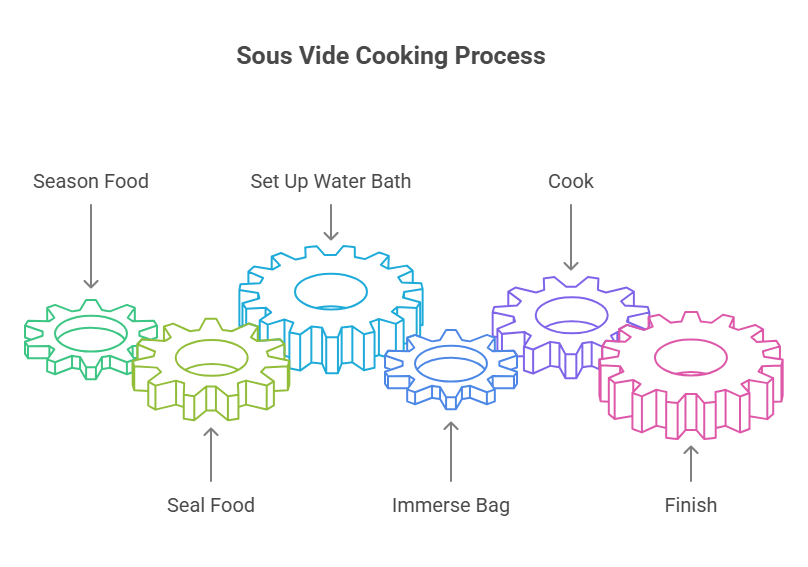
A Short History of Sous Vide Cooking
Sous vide hasn’t always been a household name. It hatched in French kitchen laboratories in the 1970s. Its original creator, French chef Georges Pralus, first worked with it in order to perfect foie gras. The technique made sure that his foie gras remained tender, flavorful and good-looking. It was around this time that “Father of Sous Vide,” Bruno Goussault, started pioneering ways to improve sous vide for larger quantities while keeping nutritional value.
Flash forward to now, sous vide cooking has escaped from its high-end restaurant kitchen prison and migrated to homes where enthusiasts, foodies and even busy parents are looking for no-fail cookery. Once the exclusive province of chefs, this method is now available to anyone with a circulator and a little curiosity, thanks to user-friendly technology.
Understanding the Science of Sous Vide Cooking
Why is sous vide so magical? It comes down (pun intended) to precision heating and timing. Traditional cooking is a risk with heat — when you roast or grill food, you’re submitting it to variable outside temperatures that make it hard to get predictable results.
Here’s what makes sous vide different:
Temperature Control—A sous vide circulator will heat the water to a uniform temperature so your food can cook evenly inside and out. Gone are the overcooked edges and raw centers.
Pasteurizing for Safety — With sous vide, you can safely hold food at lower-than-usual temperatures for longer times, killing harmful bacteria while also sealing in juices.
Segregation of Ingredients— This is important especially for people who like to eat less spicier, as this method allows us to segregate flavors and cook them properly without contamination.
Perfect Chemical Reactions — From breaking down connective tissues in meat to cooking eggs to their most luscious state, sous vide is based in the scientific perfection of food.
Example? Cooking a steak to a medium-rare 135°F is where the magic happens. Maintain it at this very temperature in the water bath, and every bit of the steak will achieve perfection — no need to second-guess.

Benefits of Sous Vide Cooking
Here’s the reason sous vide is being found in every kitchen:
Perfect Results — Every time — The sous vide method removes all guesswork. Want medium-rare steak? Never overcook it again.
Improved Flavor — A vacuum seal locks in the flavors. When your food cooks, ingredients like garlic, herbs and marinades flake in.
Consistency Across Dishes — That scramble to make each dish perfect for guests? Sous vide takes care of it.
Nutrient Preservation—Low-temperature cooking method preserves natural nutrition.
Time-Saving Hands-Off Approach — Sous vide takes time for the cooking, but you are not standing over a pot. Prepare it, put it on, and move on with your day.
Good for Batch Cooking — You can cook proteins, veggies or even grains in bulk, then refrigerate or freeze for later use.
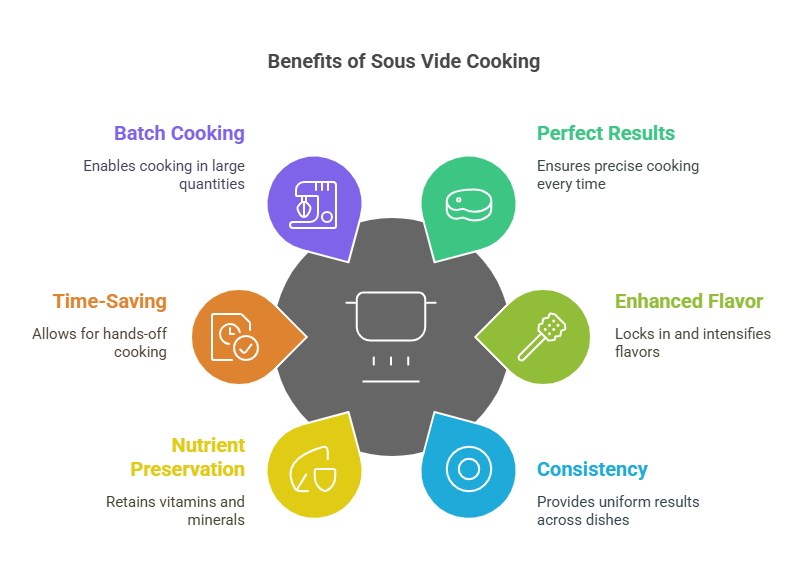
Sous Vide Cooking: A Beginner’s Guide
You don’t have to spend a fortune on high-tech gadgets to start sous vide cooking. Here’s what you’ll need:
Immersion Circulator—The main gadget that heats the water. Beginners and pros alike flock to options like Anova or Joule.
Vacuum Sealer & Bags — Preserving flavor becomes much easier with vacuum sealing. Ziplock bags work just as well if you’re on a budget (just arch the bags using the water displacement method).
Container or Pot—Just about any large water-safe receptacle can serve as a cooking pot. There are some specialized water baths provided by some brands.
Finishing tools — After sous vide, you’ll want some good cast-iron skillet or torch to sear proteins to get that perfect crust.
Once you have the basics, all you need is time!
How to Cook Sous Vide: The Complete Step-by-Step Guide
So follow these steps and get yourself sous vide cooking like a pro:
Prepare Ingredients — Generously season your food, and add any aromatics or marinades.
SEAL IT —Use vacuum-seal or a good ziplock bag (for airtight closing).
Set the Temperature—Find the target temperature for what you’re cooking (salmon is 122°F, chicken breast is 145°F).
Cook Samples — 1 to 4 hours depending on the type of food (steak, for example). Don’t worry, extended cook times have no chance of overcooking your food.
Dry and Sear — Take the food out, transfer it to a paper towel to pat it dry, then sear it for a golden-brown crust.
It’s that simple.
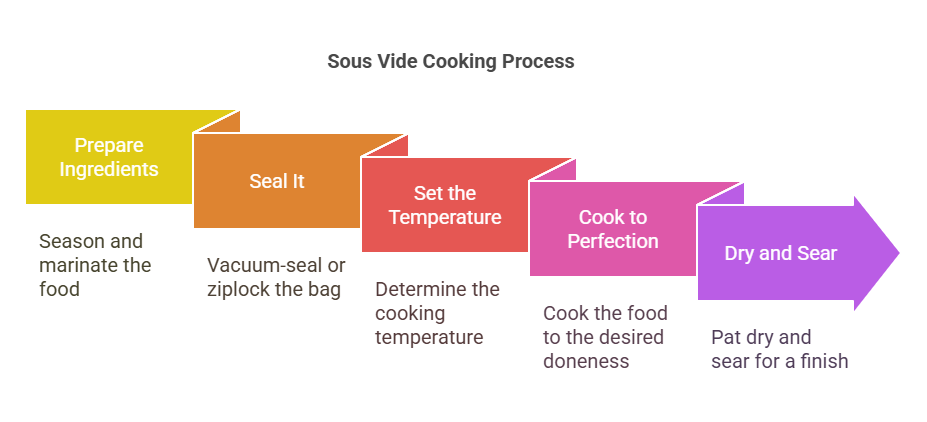
Master these sous vide recipes
Looking for inspiration? Try these beginner-friendly recipes:
Perfect Steak–Get uniform color from edge to edge. Cook to 130°F for medium-rare; sear for 1 minute per side.
Juicy Chicken Breast—145° for 1 hour produced the juiciest chicken.
Soft-Cooked Eggs – 45 minutes at 147°F for ramen-quality perfection.
Green Veggies — Carrots, asparagus and broccoli really shine when cooked sous vide.
Elegant Desserts — Put fruits or make custards easily.
Tips for Sous Vide Cooking Beginners
Keep it simple — Don’t overthink it. But stick to steak or chicken until you are comfortable before crossing into complicated terrain.
Use Quality Ingredients — Because sous vide allows the natural flavor to come through, your starting point should be quality cuts of meat or crisp, fresh vegetables.
Get It Right—The magic of sous vide comes at the end, with a sear, broil, or garnish. The pro trickInvest in a cast-iron skillet or torch for finishing.
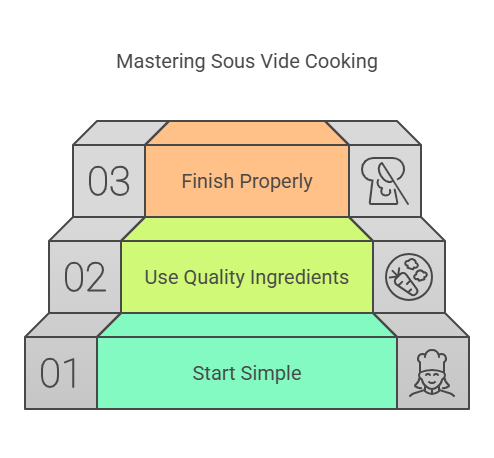
Reasons You Should Use Sous Vide in Your Kitchen
Sous vide is not just a trend; it’s a precision technique that allows home cooks to achieve professional-level results with very little work. If you’re a foodie, busy parent, or aspiring chef, sous vide will revolutionize the way you cook.
So get experimenting and take your cooking up a couple notches! Got a sous vide tip or a recipe? Let us know in the comments below!
📌 Stay connected with us!
- Follow us on Instagram: @RoastedKitchen25 for daily cooking inspiration.
- Tag us in your creations using #RoastedKitchensousvide—we’d love to see what you make!
- Subscribe to our newsletter for exclusive recipes, expert tips, and kitchen hacks straight to your inbox!
FAQ: Sous Vide Cooking
The Best Foods for Sous Vide Cooking?
You can do a lot of things with sous vide, and it actually handles a lot of different foodstuffs. Here are some of the best ones:
PROTEINS: Steak, chicken, pork, fish and lamb are sous vide staples. Thick cuts such as brisket or short ribs require a longer cook time, and more delicate fish and seafood can be cooked to perfection without turning mushy.
Vegetables: Carrots, asparagus, broccoli and other root veggies excel under sous vide, keeping their bright flavors and crunch.
Droppings: Eggs shine sous vide because they tend to be runny and creamy.
Desserts: Custards, cheesecake and infused fruits are great in sous vide.
Can I sous vide food too long?
Because sous vide uses a consistent temperature, you can’t technically overcook food in the traditional sense. But it does mean some foods, such as fish, shouldn’t stay in the water bath for long — they’ll develop a pate-like mushiness. Tougher proteins can stand up to long cooking times without issue. The times for each ingredient should be followed to prevent any texture changes.
Is Sous Vide safe?
Yes, sous vide can be safe as long as you follow appropriate temperature and time guidelines. Cooking food to exact temperatures guarantees pasteurization, which eliminates harmful bacteria. Always vacuumseal your food tightly, and do not crosscontaminate other surfaces in the kitchen while preparing it. Storing correctly once the food is cooked is equally crucial.
Is it necessary to have expensive equipment to start Sous Vide?
No, you can easily start sous vide cooking without a big investment:
The only must-have is an immersion circulator, which is quite affordable.
If you don’t have a vacuum sealer, you can also use resealable ziplock bags with the water displacement method.
Virtually any deep, heat proof container or pot will do as a water bath.
If you want, you can build your setup over time to take it to another level.
How to Store Leftover Sous Vide Food?
To store sous vide leftovers:
Control the cooking and temperature quickly by going into an ice bath with the vacuum-sealed bag.
Keep the food in its sealed bag in the refrigerator for a few days, or freeze it for longer-term storage.
To reheat sous vide leftovers, place them back in the water bath at their original cooking temperature and keep them there until warmed through.
What are some misconceptions myths about Sous Vide?
“It’s just for fancy chefs or pricey kitchens.” Not at all! Thus sous vide became accessible to home cooks with cheap immersion circulators.
“It’s too complicated.” The whole thing is pretty straightforward—you season, seal, cook and sear.
“Don’t use sous vide except for red meat.” Though it’s a go-to for steak, it works wonderfully for chicken, fish, eggs, veggies and even desserts.
“It’s not time-efficient.” Sous vide cooking may take longer, but it is a hands-off approach that saves active cooking time, allowing you to multitask.
So, can you sous vide without a vacuum sealer?
A vacuum sealer is not required, though. If you are using a heavy duty resealable ziplock bag, you can also use the water displacement method. To do this:
Put the food inside the bag, and wipe it most of the way closed.
Submerge it in the water bath, just short of the seal, to expel air.
Make sure to close the bag up tightly before cooking.
So, does sous vide cooking need additional kitchen space?
Not at all. The tools needed are compact. An immersion circulator slips into a drawer, and you can use any pot or container you already have for the water bath.
Is sous vide sustainable?
Sous vide encourages energy-efficient cooking; immersion circulators use much less power than ovens or stovetops. Reusable vacuum bags and careful portioning also help reduce food and plastic waste.
With sous vide, cooking is less stressful, more precise and endlessly creative. Whether you’re cooking for guests or putting together a quick weeknight dinner, this method has something for everyone. Have more questions? Leave them in the comments, and happy cooking!

Hi, I’m Mayaz Ahsan!
As a passionate cook, storyteller, and food enthusiast, I combine my love for travel, farming, reading, and teaching to bring you insightful culinary tips and stories. Welcome to Roasted Kitchen – I’m thrilled to share this journey with you!

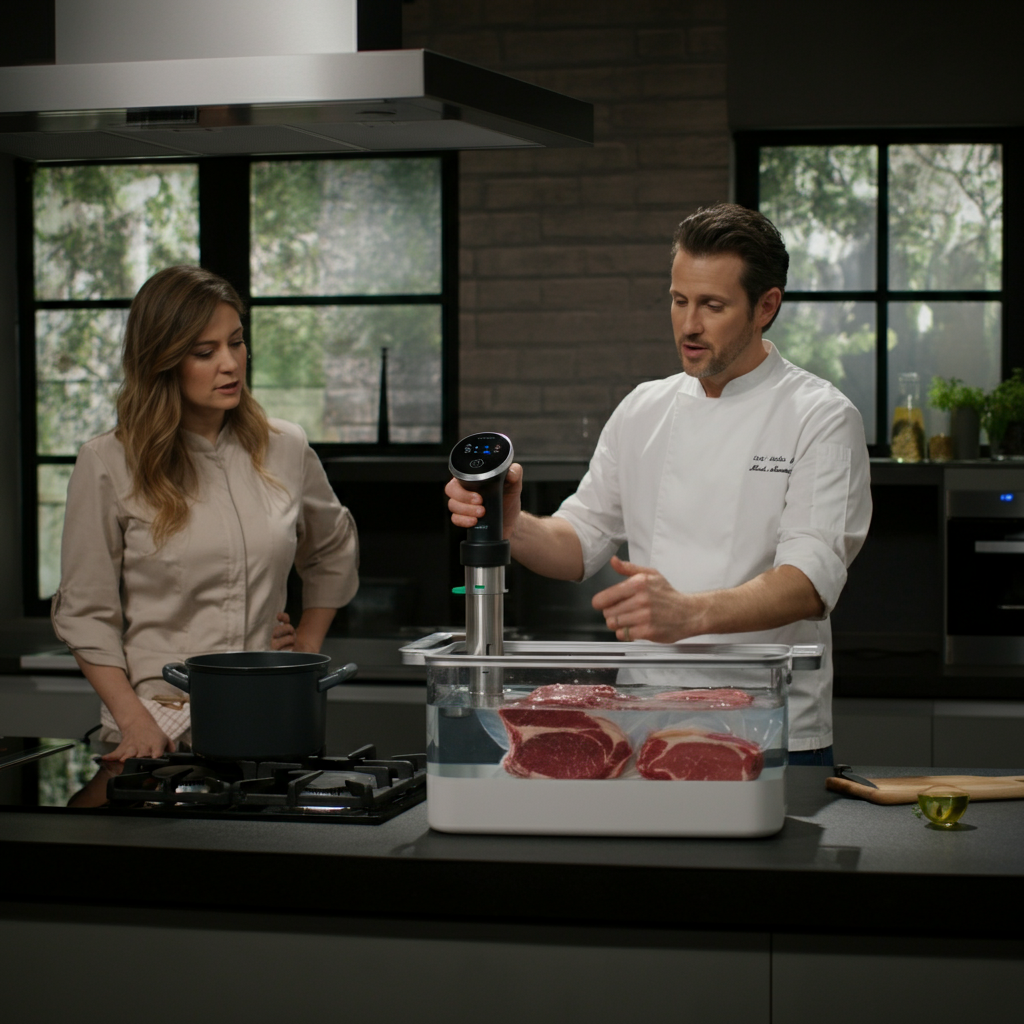








 Subscribe to our free newsletter for tips, tutorials, and insights!
Subscribe to our free newsletter for tips, tutorials, and insights!